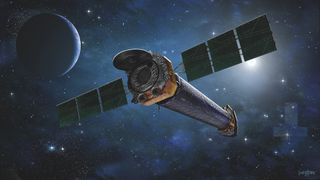NASA's Chandra X-ray Observatory suffers camera glitch, stalling science

A prolific NASA space telescope has closed its camera eye for now due to a power issue that has stalled the observatory's science work.
The Chandra X-ray Observatory, which has studied the X-ray universe since 1999, suffered a power supply problem with its High Resolution Camera instrument on Feb. 9, leading the mission team to halt science observations for now.
"Chandra mission specialists have paused science operations and put the four science instruments into safe mode while they analyze the situation and determine the appropriate response," Chandra mission officials wrote in an update today (Feb. 16). "The spacecraft itself is operating normally."
Gallery: Amazing nebula photos from Chandra & Hubble
A notice released on Twitter by the Chandra X-ray Center's director's office stated that the space telescope's High Resolution Camera was "powered down after being discovered in an anomalous state" and that "the cause is currently under investigation."
The space telescope is expected to resume normal operation with a different instrument, called the Advanced CCD Imaging Spectrograph or ACIS, by early next week, the statement said.
Originally designed to last just five years, the Chandra X-ray space telescope has spent more than two decades observing the universe in the X-ray range of the light spectrum to study the structure and evolution of the universe. It was launched into orbit on July 23, 1999 aboard the space shuttle Columbia.
Get the Space.com Newsletter
Breaking space news, the latest updates on rocket launches, skywatching events and more!
Chandra's current glitch isn't the first for its High Resolution Camera. In August 2020, the camera was knocked offline by a different anomaly that sidelined its science operations for months.
Chandra controllers eventually switched the camera to a back-up set of electronics and performed a detailed study of the system before restoring it to full health in December 2020.
In addition, the observatory suffered a gyroscope problem in 2018 that was also fixed.
The space telescope is currently on an extended mission that is funded through 2025 and could be extended through 2030, NASA officials have said.
Email Tariq Malik at tmalik@space.com or follow him @tariqjmalik. Follow us @Spacedotcom, Facebook and Instagram.
Join our Space Forums to keep talking space on the latest missions, night sky and more! And if you have a news tip, correction or comment, let us know at: community@space.com.

Tariq is the Editor-in-Chief of Space.com and joined the team in 2001, first as an intern and staff writer, and later as an editor. He covers human spaceflight, exploration and space science, as well as skywatching and entertainment. He became Space.com's Managing Editor in 2009 and Editor-in-Chief in 2019. Before joining Space.com, Tariq was a staff reporter for The Los Angeles Times covering education and city beats in La Habra, Fullerton and Huntington Beach. In October 2022, Tariq received the Harry Kolcum Award for excellence in space reporting from the National Space Club Florida Committee. He is also an Eagle Scout (yes, he has the Space Exploration merit badge) and went to Space Camp four times as a kid and a fifth time as an adult. He has journalism degrees from the University of Southern California and New York University. You can find Tariq at Space.com and as the co-host to the This Week In Space podcast with space historian Rod Pyle on the TWiT network. To see his latest project, you can follow Tariq on Twitter @tariqjmalik.
